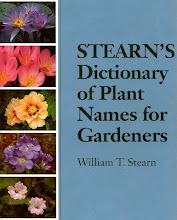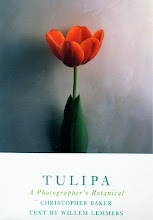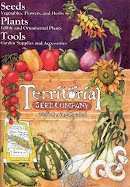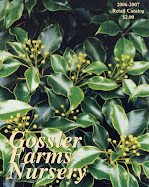Crambe maritima August 2008
Rosa glauca June 2009
Campanula carpatica May 2009
Eryngium planum August 2010
Hebe recurva March 2010
Here is a list of blue plants for Seattle, the Pacific Northwest & USDA Zone 8. Use it to find blue flowers & plants with blue, gray or silver foliage. Blue is soft & soothing. Most blue foliage is somewhat gray. Blue-gray foliage often has a fluffy, feathery look. Blue & gray look very handsome with red, contrast nicely with yellow. Blue flowers work well with gray foliage, because there is just enough contrast to make them visible, yet they also blend nicely. Purple, pink & white flowers go well with blue. Blue is calm & accepts diversity. Many plants with blue-gray & gray foliage have yellow or white flowers. Blue-gray, gray & silver foliage are tasteful additions to a white garden, especially when these plants have white flowers. Plants with blue-gray or gray foliage & yellow flowers are perfect for a blue & yellow garden, an arresting combination. The terms glaucus, glauca & glaucum mean that the plants have a fine, whitish, powdery coating, usually on the leaves, but fruits can also be glaucus. Xeric plants don't usually need irrigation. This list is meant to introduce you to these plants & give basic information. Further research will be needed to find sizes & specific horticultural requirements.
Trees: all for sun
Abies concolor 'Candicans' (White Fir) Abies pinsapo 'Glauca' (Spanish Fir) Abies procera 'Glauca' (Noble Fir): all with blue-gray foliage, evergreen conifers.
Cedrus atlantica 'Glauca' (Blue Atlas Cedar): blue foliage, large evergreen conifer.
Chamaecyparis lawsoniana ‘Pembury Blue’ (Port Orford Cedar) Chamaecyparis pisifera ‘Boulevard’ (Boulevard Cypress): blue foliage, evergreen conifers.
Cupressus arizonica glabra ‘Blue Ice’ (Arizona Cypress): blue foliage, evergreen conifer, xeric.
Juniperus scopulorum 'Blue Heaven' (Rocky Mountain Juniper): blue foliage, xeric; Juniperus scopulorum 'Skyrocket' (Rocky Mountain Juniper): blue gray foliage, very narrow, xeric; Juniperus virginiana 'Glauca' (Eastern Red Cedar): silver-gray foliage; all evergreen conifers.
Picea breweriana (Brewer Spruce): blue-green foliage, purple cones; Picea pungens 'Moerheim' & Picea pungens 'Thomsen' (Colorado Blue Spruce): blue foliage; evergreen conifers.
Pinus kwangtungensis (Chinese White Pine) Pinus parviflora 'Tempelhof' (Japanese White Pine): blue foliage, evergreen conifers.
Pyrus salicifolia ‘Pendula’ (Weeping Willowleaf Pear): silver-gray foliage, white flowers
Sequoia sempervivum ‘Filoli’ (Coast Redwood): blue foliage, large evergreen conifer
Shrubs
Abies concolor 'Compacta' (Dwarf White Fir) Abies lasiocarpa 'Compacta' (Dwarf Alpine Fir): blue-gray foliage, evergreen conifers.
Caryopteris x clandonensis (Blue Mist) Caryopteris incana (Bluebeard): blue flowers, sun.
Ceanothus impressus 'Vandenberg' (Santa Barbara Mountain Lilac) Ceanothus thyrsiflorus 'Victoria' aka 'Skylark' (Blue Blossom): xeric, showy bloom, not long-lived, these 2 are the most commonly grown in Seattle, others may suffer frost damage.
Cedrus atlantica 'Glauca Pendula' (Weeping Atlas Cedar): blue foliage, evergreen conifer.
Chamaecyparis lawsoniana ‘Blue Surprise’: surprisingly blue foliage, sun, evergreen conifer
Elaeagnus commutata (Silverberry): silver foliage, silver fruit, small yellow flowers, sun, xeric.
Hebe recurva, Hebe topiaria: blue-gray foliage, white flowers, sun, evergreen
Hydrangea macrophylla 'All Summer Beauty', Hydrangea macrophylla ' Blue Wave', Hydrangea macrophylla ‘Blue Billow’, Hydrangea macrophylla 'Endless Summer', Hydrangea macrophylla ‘Nikko Blue’ (Bigleaf Hydrangea including Lacecap & Mophead): & other culvivars, blue flowers, part shade, in alkaline soil flowers will be pink.
Juniperus squamata 'Blue Star': silver-blue foliage, Juniperus squamata 'Loderi': blue-green foliage, Juniperus squamata 'Chinese Silver': silver-blue-green foliage; all for sun, evergreen conifers
Lavandula angustifolia (English Lavender) Lavandula dentata (French Lavender): blue flowers with silver-gray foliage, sun, xeric.
Lithocarpus densiflorus var. echinoides (Dwarf Tanoak): blue-green foliage, evergreen.
Picea pungens 'Globosa', Picea pungens 'Montgomery' & Picea pungens 'Procumbens' (Dwarf Colorado Blue Spruce): blue foliage, evergreen conifer.
Rhododendron 'Blue Peter': blue flowers, shade, evergreen.
Rosa glauca: blue foliage with pink tinge, pink flowers, sun.
Rosmarinus officinalis 'Tuscan Blue': & other cultivars, blue flowers, sun, xeric, evergreen, culinary herb.
Santolina chamaecyparissus (Lavender Cotton): silver foliage, yellow flowers, sun, xeric
Senecio greyi (aka Brachyglottis 'Sunshine'): gray foliage, yellow flowers, evergreen
Perennials: all with blue flowers, except as noted
Agapanthus campanulatus, Agapanthus ‘Headbourne Hybrids’, Agapanthus ‘Midnight Blue’, Agapanthus ‘Peter Pan’ (Lily of the Nile): & other cultivars, these are all derived from Agapanthus campanulatus, the only reliable hardy species in USDA Zone 8, sun.
Allium azureum (Ornamental Onion): sun, xeric.
Baptisia australis (False Indigo): sun, tolerates some dryness.
Brunnera macrophylla 'Jack Frost': shade, silvery leaves & blue flowers, shade.
Campanula glomerata (Clustered Bellflower) Campanula lactiflora, Campanula latifolia, Campanula latiloba, Campanula persicifolia (Peachleaf Bellflower): & other species, many cultivars, sun.
Chionodoxa luciliae (Glory of the Snow): sun.
Clematis integrifolia: sun, not a vine
Corydalis ‘Blue Panda’: shade, needs moisture.
Crambe maritima (Sea Kale): blue-gray foliage, white flowers, sun, xeric.
Cynara cardunculus (Cardoon): silver-gray foliage, blue flowers, sun.
Deinanthe caerulea: shade, needs moisture.
Echinops ritro (Globe Thistle): sun, xeric
Erigeron glaucus (Beach Aster) Erigeron speciosus (Showy Fleabane): xeric
Eryngium alpinum, Eryngium amethystinum, Eryngium bourgatii, Eryngium planum (Sea Holly): sun, xeric
Euphorbia characias, Euphorbia nicaeensis, Euphorbia rigida (Spurge): gray foliage, yellow flowers, xeric
Festuca ovina ‘Glauca’ (Blue Fescue): blue foliage
Gentiana affinis, Gentiana cruciata, Gentiana septemfida, Gentiana tianschanica, Gentiana verna (Gentian): many species, sun, some need moisture.
Hepatica americana, Hepatica nobilis (Liverwort): shade.
Hyacinthus orientalis 'Blue Jacket', Hyacinthus orientalis 'Blue Pearl', Hyacinthus orientalis ‘Delft Blue’ (Dutch Hyacinth): sun.
Iris 'Blue Magic' (Dutch Iris) Iris douglasiana (Doulgas Iris): xeric; Iris missouriensis, Iris reticulata 'Harmony', Iris sibirica 'Bennerup Blue' (Siberian Iris) Iris tenax (Oregon Iris): many species & cultivars with blue flowers, sun.
Limonium latifolium (Statice): sun.
Meconopsis betonicifolia (Himalayan Poppy) Meconopsis grandis, Meconopsis x sheldonii: shade, needs moisture, can be difficult to grow.
Mertensia ciliata (Mountain Bluebell) Mertensia pulmonarioides (Virginia Bluebells): shade, needs moisture.
Muscari armeniacum, Muscari latifolium, Muscari neglectum, Muscari paradoxum (Grape Hyacinth): sun or part shade.
Myosotis scorpioides (Perennial Forget-Me-Not): part shade
Omphalodes cappadocica, Omphalodes verna: shade, needs moisture.
Platycodon grandiflorus (Balloon Flower): sun.
Penstemon heterophyllus, Penstemon montanus, Penstemon serrulatus, Penstemon procerus, Penstemon strictus, Penstemon virens (Beardtongue): & other species, sun, many are xeric.
Perovskia atriplicifolia (Russian Sage): gray foliage & blue flowers
Prunella grandiflora, Prunella vulgaris (Self Heal): sun.
Pulmonaria angustifolia, Pulmonaria longifolia, Pulmonaria saccharata (Lungwort): & cultivars, shade
Salvia nemorosa 'Superba', Salvia x sylvestris 'Mainacht' (Sage): & other species, sun.
Scilla peruviana: sun, xeric, from Spain not Peru.
Stachys byzantina (Lamb’s Ears): gray foliage, pink flowers, sun, xeric.
Tradescantia virginiana 'Zwanenburg Blue' (Spiderwort): sun or part shade.
Triteleia laxa 'Queen Fabiola': sun, xeric.
Veronica spicata (Speedwell): many cultivars, sun.
Groundcovers & Trailers
Ajuga reptans (Carpet Bugle): many cultivers, blue flowers, sun or part shade.
Campanula carpatica (Carpathian Harebell) Campanula portenschlagiana (Dalmatian Bellflower) Campanula poscharskyana (Serbian Bellflower): blue flowers
Cerastium tomentosum (Snow in Summer): gray foliage, white flowers, short lived.
Convolvulus sabatius (Ground Morning Glory): blue flowers, sun.
Euphorbia myrsinites (Myrtle Spruge): blue-gray foliage, yellow flowers, sun, xeric
Hebe glaucophylla: blue-gray foliage, white flowers, Hebe x pimeleoides: blue-gray foliage, blue flowers, Hebe pinguifolia 'Pagei': blue-gray foliage, white flowers; all for sun, low evergreen shrubs with creeping stems.
Juniperus conferta 'Pacific Blue' (Shore Juniper) Juniperus horizontalis 'Blue Chip' (Creeping Juniper) Juniperus squamata 'Blue Carpet': blue foliage, sun, low evergreen shrubs with creeping stems.
Lithodora diffusa: blue flowers, sun, xeric.
Pratia pedunculata (Blue Star Creeper): sun.
Rosmarinus officinalis ‘Prostratus’ (Trailing Rosemary): sun, low evergreen shrub with creeping stems.
Sedum anacampseros: blue-green foliage, pink flowers, sun; Sedum dasyphyllum: blue-green foliage, pink flowers, sun; Sedum forsterianum: blue-green foliage, yellow flowers, shade or part-shade; Sedum obtusatum: blue-green foliage, cream flowers, sun; Sedum oregonense: blue-green foliage, yellow flowers, sun; Sedum reflexum 'Blue Spruce': blue-green foliage, yellow flowers, sun; all xeric.
Veronica pectinata, Veronica peduncularis 'Georgia Blue', Veronica prostrata 'Heavenly Blue': blue flowers, xeric.










































































